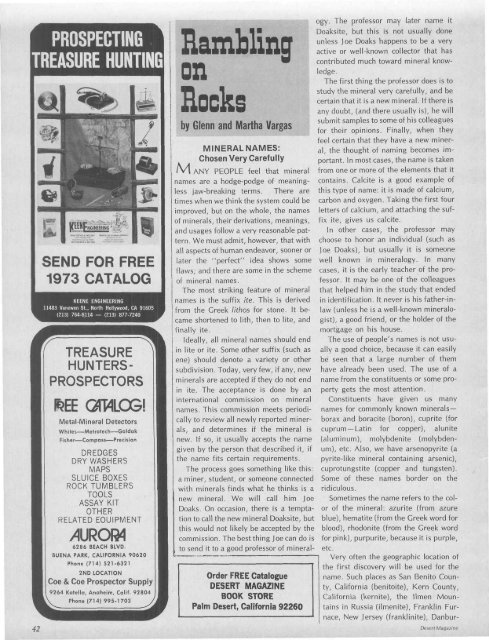Desert Magazine Book Shop - Desert Magazine of the Southwest
Desert Magazine Book Shop - Desert Magazine of the Southwest
Desert Magazine Book Shop - Desert Magazine of the Southwest
Create successful ePaper yourself
Turn your PDF publications into a flip-book with our unique Google optimized e-Paper software.
PROSPECTING<br />
TREASURE HUNTING<br />
SEND FOR FREE<br />
1973 CATALOG<br />
KEENE ENGINEERING<br />
11483 Vanowen St., North Hollywood, CA 91605<br />
(213) 764-6114 — (213) 877-7240<br />
TREASURE<br />
HUNTERS-<br />
PROSPECTORS<br />
fcEE 0IT4L0G!<br />
Metal-Mineral Detectors<br />
Whites—Metrotech—Goldok<br />
Fisher—Compass—Precision<br />
DREDGES<br />
DRY WASHERS<br />
MAPS<br />
SLUICE BOXES<br />
ROCK TUMBLERS<br />
TOOLS<br />
ASSAY KIT<br />
OTHER<br />
RELATED EOUIPMENT<br />
6286 BEACH BLVD.<br />
BUENA PARK, CALIFORNIA 90620<br />
Phone (714) 521-6321<br />
2ND LOCATION<br />
Coe & Coe Prospector Supply<br />
9264 Katella, Anaheim, Calif. 92804<br />
Phone (714) 995-1703<br />
Rambling<br />
Hocks<br />
by Glenn and Martha Vargas<br />
MINERAL NAMES:<br />
Chosen Very Carefully<br />
/Vl ANY PEOPLE feel that mineral<br />
names are a hodge-podge <strong>of</strong> meaningless<br />
jaw-breaking terms. There are<br />
times when we think <strong>the</strong> system could be<br />
improved, but on <strong>the</strong> whole, <strong>the</strong> names<br />
<strong>of</strong> minerals, <strong>the</strong>ir derivations, meanings,<br />
and usages follow a very reasonable pattern.<br />
We must admit, however, that with<br />
all aspects <strong>of</strong> human endeavor, sooner or<br />
later <strong>the</strong> "perfect" idea shows some<br />
flaws; and <strong>the</strong>re are some in <strong>the</strong> scheme<br />
<strong>of</strong> mineral names.<br />
The most striking feature <strong>of</strong> mineral<br />
names is <strong>the</strong> suffix ite. This is derived<br />
from <strong>the</strong> Creek lithos for stone. It became<br />
shortened to Nth, <strong>the</strong>n to lite, and<br />
finally ite.<br />
Ideally, all mineral names should end<br />
in lite or ite. Some o<strong>the</strong>r suffix (such as<br />
ene) should denote a variety or o<strong>the</strong>r<br />
subdivision. Today, very few, if any, new<br />
minerals are accepted if <strong>the</strong>y do not end<br />
in ite. The acceptance is done by an<br />
international commission on mineral<br />
names. This commission meets periodically<br />
to review all newly reported minerals,<br />
and determines if <strong>the</strong> mineral is<br />
new. If so, it usually accepts <strong>the</strong> name<br />
given by <strong>the</strong> person that described it, if<br />
<strong>the</strong> name fits certain requirements.<br />
The process goes something like this:<br />
a miner, student, or someone connected<br />
with minerals finds what he thinks is a<br />
new mineral. We will call him Joe<br />
Doaks. On occasion, <strong>the</strong>re is a temptation<br />
to call <strong>the</strong> new mineral Doaksite, but<br />
this would not likely be accepted by <strong>the</strong><br />
commission. The best thing Joe can do is<br />
to send it to a good pr<strong>of</strong>essor <strong>of</strong> mineral-<br />
Order FREE Catalogue<br />
DESERT MAGAZINE<br />
BOOK STORE<br />
Palm <strong>Desert</strong>, California 92260<br />
ogy. The pr<strong>of</strong>essor may later name it<br />
Doaksite, but this is not usually done<br />
unless Joe Doaks happens to be a very<br />
active or well-known collector that has<br />
contributed much toward mineral knowledge.<br />
The first thing <strong>the</strong> pr<strong>of</strong>essor does is to<br />
study <strong>the</strong> mineral very carefully, and be<br />
certain that it is a new mineral. If <strong>the</strong>re is<br />
any doubt, (and <strong>the</strong>re usually is), he will<br />
submit samples to some <strong>of</strong> his colleagues<br />
for <strong>the</strong>ir opinions. Finally, when <strong>the</strong>y<br />
feel certain that <strong>the</strong>y have a new mineral,<br />
<strong>the</strong> thought <strong>of</strong> naming becomes important.<br />
In most cases, <strong>the</strong> name is taken<br />
from one or more <strong>of</strong> <strong>the</strong> elements that it<br />
contains. Calcite is a good example <strong>of</strong><br />
this type <strong>of</strong> name: it is made <strong>of</strong> calcium,<br />
carbon and oxygen. Taking <strong>the</strong> first four<br />
letters <strong>of</strong> calcium, and attaching <strong>the</strong> suffix<br />
ite, gives us calcite.<br />
In o<strong>the</strong>r cases, <strong>the</strong> pr<strong>of</strong>essor may<br />
choose to honor an individual (such as<br />
Joe Doaks), but usually it is someone<br />
well known in mineralogy. In many<br />
cases, it is <strong>the</strong> early teacher <strong>of</strong> <strong>the</strong> pr<strong>of</strong>essor.<br />
It may be one <strong>of</strong> <strong>the</strong> colleagues<br />
that helped him in <strong>the</strong> study that ended<br />
in identification. It never is his fa<strong>the</strong>r-inlaw<br />
(unless he is a well-known mineralogist),<br />
a good friend, or <strong>the</strong> holder <strong>of</strong> <strong>the</strong><br />
mortgage on his house.<br />
The use <strong>of</strong> people's names is not usually<br />
a good choice, because it can easily<br />
be seen that a large number <strong>of</strong> <strong>the</strong>m<br />
have already been used. The use <strong>of</strong> a<br />
name from <strong>the</strong> constituents or some property<br />
gets <strong>the</strong> most attention.<br />
Constituents have given us many<br />
names for commonly known mineralsborax<br />
and boracite (boron), cuprite (for<br />
cuprum —Latin for copper), alunite<br />
(aluminum), molybdenite (molybdenum),<br />
etc. Also, we have arsenopyrite (a<br />
pyrite-like mineral containing arsenic),<br />
cuprotungstite (copper and tungsten).<br />
Some <strong>of</strong> <strong>the</strong>se names border on <strong>the</strong><br />
ridiculous.<br />
Sometimes <strong>the</strong> name refers to <strong>the</strong> color<br />
<strong>of</strong> <strong>the</strong> mineral: azurite (from azure<br />
blue), hematite (from <strong>the</strong> Greek word for<br />
blood), rhodonite (from <strong>the</strong> Greek word<br />
for pink), purpurite, because it is purple,<br />
etc.<br />
Very <strong>of</strong>ten <strong>the</strong> geographic location <strong>of</strong><br />
<strong>the</strong> first discovery will be used for <strong>the</strong><br />
name. Such places as San Benito County,<br />
California (benitoite), Kern County,<br />
California (kernite), <strong>the</strong> llmen Mountains<br />
in Russia (ilmenite), Franklin Furnace,<br />
New Jersey (franklinite), Danbur-<br />
<strong>Desert</strong> <strong>Magazine</strong>

















